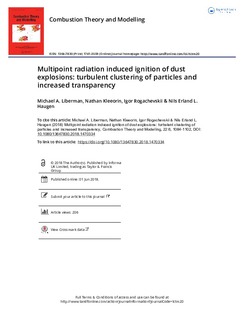| dc.contributor.author | Liberman, Michael A. | |
| dc.contributor.author | Kleeorin, Nathan | |
| dc.contributor.author | Rogachevskii, Igor | |
| dc.contributor.author | Haugen, Nils Erland L | |
| dc.date.accessioned | 2019-01-09T13:06:09Z | |
| dc.date.available | 2019-01-09T13:06:09Z | |
| dc.date.created | 2018-06-19T08:40:06Z | |
| dc.date.issued | 2018 | |
| dc.identifier.citation | Combustion theory and modelling. 2018, 22 (6), 1084-1102. | nb_NO |
| dc.identifier.issn | 1364-7830 | |
| dc.identifier.uri | http://hdl.handle.net/11250/2579984 | |
| dc.description.abstract | Understanding the causes and mechanisms of large explosions, especially dust explosions, is essential for minimising devastating hazards in many industrial processes. It is known that unconfined dust explosions begin as primary (turbulent) deflagrations followed by a devastating secondary explosion. The secondary explosion may propagate with a speed of up to 1000 m/s producing overpressures of over 8–10 atm, which is comparable with overpressures produced in detonation. Since detonation is the only established theory that allows rapid burning producing a high pressure that can be sustained in open areas, the generally accepted view was that the mechanism explaining the high rate of combustion in dust explosions is deflagration-to-detonation transition. In the present work we propose a theoretical substantiation of an alternative mechanism explaining the origin of the secondary explosion producing high speeds of combustion and high overpressures in unconfined dust explosions. We show that the clustering of dust particles in a turbulent flow ahead of the advancing flame front gives rise to a significant increase of the thermal radiation absorption length. This effect ensures that clusters of dust particles are exposed to and heated by radiation from hot combustion products of dust explosions for a sufficiently long time to become multi-point ignition kernels in a large volume ahead of the advancing flame. The ignition times of a fuel–air mixture caused by radiatively heated clusters of particles is considerably reduced compared with the ignition time caused by an isolated particle. Radiation-induced multipoint ignitions of a large volume of fuel–air ahead of the primary flame efficiently increase the total flame area, giving rise to the secondary explosion, which results in the high rates of combustion and overpressures required to account for the observed level of overpressures and damage in unconfined dust explosions, such as for example the 2005 Buncefield explosion and several vapour cloud explosions of severity similar to that of the Buncefield incident. © 2018 The Author(s). Published by Informa UK Limited, trading as Taylor & Francis Group | nb_NO |
| dc.language.iso | eng | nb_NO |
| dc.publisher | Taylor & Francis | nb_NO |
| dc.rights | Attribution-NonCommercial-NoDerivatives 4.0 Internasjonal | * |
| dc.rights.uri | http://creativecommons.org/licenses/by-nc-nd/4.0/deed.no | * |
| dc.title | Multipoint radiation induced ignition of dust explosions: turbulent clustering of particles and increased transparency | nb_NO |
| dc.type | Journal article | nb_NO |
| dc.type | Peer reviewed | nb_NO |
| dc.description.version | publishedVersion | nb_NO |
| dc.source.pagenumber | 1084-1102 | nb_NO |
| dc.source.volume | 22 | nb_NO |
| dc.source.journal | Combustion theory and modelling | nb_NO |
| dc.source.issue | 6 | nb_NO |
| dc.identifier.doi | 10.1080/13647830.2018.1470334 | |
| dc.identifier.cristin | 1592094 | |
| dc.description.localcode | © 2018 The Author(s). Published by Informa UK Limited, trading as Taylor & Francis Group This is an Open Access article distributed under the terms of the Creative Commons Attribution-NonCommercial-NoDerivatives License (http://creativecommons.org/licenses/by-nc-nd/4.0/) | nb_NO |
| cristin.unitcode | 194,64,25,0 | |
| cristin.unitname | Institutt for energi- og prosessteknikk | |
| cristin.ispublished | true | |
| cristin.fulltext | original | |
| cristin.qualitycode | 1 | |

